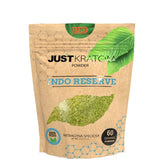When it comes to kratom, dosage really matters. That's because kratom's effects change with the amount you take. Smaller doses can give you a mild, coffee-like boost. Medium doses offer sedative and pain-relieving effects, similar to opioids. But be careful— because taking too much can lead to serious, toxic effects.

We would love to offer a one-size-fits-all dosing guide for the perfect kratom experience, but unfortunately it's a bit more complicated than that. (So please keep that in mind when trying to figure out how much is right for you!) Several factors influence the ideal dose, such as:
- Kratom strain (red, green, or white vein)
- Consumption method (tablets, tea, raw leaves, etc.)
- Personal tolerance (affected by genetics and frequency of use)
- Metabolic rate (how quickly your body processes kratom)
- Body composition (weight and body fat percentage)
- Frequency of use (daily vs occasional consumption)
- Set and setting (expectations and environment)
Since kratom is still relatively new to the western world, we're awaiting more research to fully understand proper dosing. Meanwhile, we've gathered all the current, up-to-date knowledge so we can help you determine your optimal kratom dosage.

So, What is Kratom?
Kratom comes from the Mitragyna speciosa tree, which is a close relative of the coffee plant. This tropical tree packs a punch with over 25 bioactive alkaloids, but the stars of the show are mitragynine and 7-hydroxymitragynine. These two compounds play the biggest roles in delivering kratom's mind and body effects.
These alkaloids interact with opioid receptors in your body, creating effects similar to opioids. They also likely engage with serotonin, dopamine, and norepinephrine receptors, contributing to kratom's mood and energy-boosting benefits.

What Are the Effects of Kratom?
In Southeast Asia, kratom is much like coffee in the Western world. It's a socially acceptable, daily pick-me-up that boosts alertness and physical energy in small doses.
While kratom acts as a coffee-like stimulant at lower doses, its recent popularity in the West is more likely due to its opioid-like effects at higher doses. Though not technically an opioid, kratom interacts with opioid receptors to produce similar effects. It’s more accessible and generally safer than traditional opioids, making it a popular choice for pain relief, a legal high, or even to help with opioid withdrawal symptoms.

Is Kratom Right For Me?
When it comes to finding the right kratom dosage, knowing your specific goal is key. People turn to kratom for a variety of reasons, and here are the four main motivations:
- Pain relief
- Boosting energy
- Treating opioid withdrawal
- Replacing opioids or recreational substances like alcohol
Having a clear purpose in mind will help you determine the best way to use kratom for your needs.
Kratom Dosage Chart
Here’s a quick guide to what you can expect from different doses of kratom. Keep in mind, these effects are based on grams of raw kratom leaves, not just the active compound, mitragynine, which is more potent on its own. So, let's break it down:
- 1-2 grams: Light, coffee-like stimulation and mood enhancement.
- 2-4 grams: Noticeable energy boost, increased alertness, and mild euphoria.
- 4-6 grams: Balanced effects with both stimulation and pain relief.
- 6-8 grams: Stronger pain relief, relaxation, and mild sedative effects.
- 8+ grams: Deep relaxation, strong pain relief, and potentially sedative effects similar to opioids.
Remember, the right dose for you depends on your personal goals and tolerance. Start low and adjust as needed!

How Long Does Kratom Take to Kick In?
Just like with any new supplement, it's best to start low and go slow when trying kratom. You'll want to know how long it takes to feel the effects so you can adjust your dosage accordingly.
Kratom typically kicks in about 5 to 10 minutes after you take it. The effects can last for five to seven hours, with the peak happening around two to four hours in. Since the effects build up over time, it's smart to wait at least 30 minutes to an hour before deciding if you need a bit more. This way, you can find your perfect dose without overdoing it.
How Long Does Kratom Stay in Your System?
How often you use kratom plays a big role in how long it stays in your system. Even after the effects wear off, kratom can linger. Regular users might need higher doses over time to achieve the same effects due to built-up tolerance. Typically, residual mitragynine can remain in your system for up to a week.
What Happens If You Take Too Much Kratom?
Like its positive effects, the negative side effects of kratom also vary based on dosage. The most common ones include constipation, gastrointestinal issues, and agitation.
Regular use of kratom can lead to addiction, with nearly half of regular users experiencing withdrawal symptoms after just two days without it.
Taking doses exceeding 15g may result in symptoms similar to opioid toxicity. While kratom is considered less risky than true opioids due to its lower likelihood of causing fatal respiratory depression, it's still important to have Naloxone on hand in case of overdose.
However, the primary concern with kratom use lies in its potential interactions with other drugs. The most important precaution to take when using kratom is to avoid mixing it with any other substances, including pharmaceuticals, alcohol, and cannabis.

What is a Typical Dose of Kratom?
According to a survey conducted among regular kratom users in the United States, the typical dose ranges from 1 to 7 grams. Approximately half of the users opt for doses between 1 and 3 grams per day, while about 30% prefer doses of 4 to 6 grams.
At these lower doses, most individuals report experiencing only mild adverse effects, if any. Adverse effects are believed to become more noticeable with doses exceeding 8 grams. Based on this information, you may find the most benefits and fewest side effects when consuming kratom in doses ranging from 1 to 5 grams.
Daily users typically consume kratom in various forms, including prepared beverages, raw powder, or capsules. The method of consumption could also impact safety, as it may be easier to unintentionally consume too much powder or capsules compared to a brewed tea.
Top Tips for Safe Kratom Dosing
Essentially, personal awareness and understanding your own goals are crucial for using kratom safely. Keep in mind that everyone reacts differently, and comprehensive research is still limited.

Here are are best tips for safely dosing kratom:
- Do not mix kratom with any other substances, whether they're medications or recreational drugs like alcohol.
- Begin with the smallest effective dose for your desired outcome, whether it's boosting energy, relieving pain, or managing withdrawal symptoms.
- If you're new to kratom, start with a dose below 1 gram, and give it about 30 to 60 minutes to gauge its effects before considering increasing your dosage.
- To minimize the risk of adverse effects, it's generally advisable not to surpass a dose of 8 grams.
Getting Started with Kratom
Remember, using kratom safely is all about knowledge and moderation. If you have any questions or need guidance on your kratom journey, don't hesitate to reach out to us at Gold Dragon Kratom. We're here to support you every step of the way!





